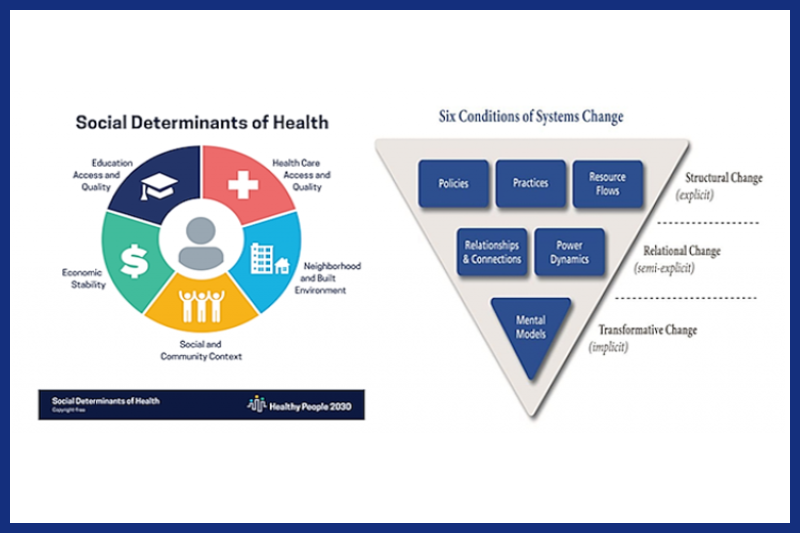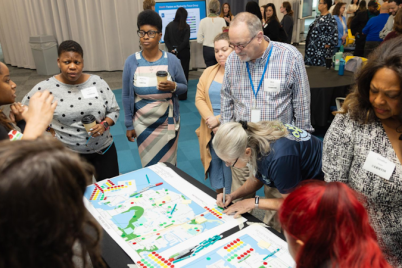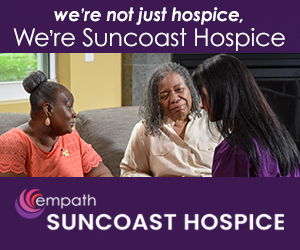A new grant will support multi-sector collaborations that advance systemic changes in the factors that shape our community’s health
DR. KANIKA TOMALIN | President and CEO of the Foundation for a Healthy St. Petersburg
At the Foundation for a Healthy St. Petersburg, we often call on a popular parable to help us understand systems change.
It’s the story of two people walking by a river who suddenly notice a baby in the water, floating downstream. One rushes in to pull the baby out, only to discover another baby behind it… then another, and another. While one friend calls for help to rescue the drowning babies, the other friend rushes upstream.
“Where are you going!?” her friend cries.
The other responds: “Upstream… to see how all of these babies are getting in the water!”
The work to create systems change happens in the “upstream” of a problem’s continuum and seeks to understand and address the root causes of its existence. It’s an approach that addresses the conditions that allow a problem to persist.
Surface change, a different and equally popular approach, focuses on solving a problem’s negative consequences.
While both approaches are important, the differences in the outcomes they produce are defining. Think of the challenges our community comes together to solve as a persistent cough a patient has been enduring for months. A surface change approach would be to prescribe a medication that suppresses the cough and provides temporary relief. A systems change approach would recognize that the cough is a symptom of a more complex illness and seek a solution that cures the cough by treating its underlying cause.
At the Foundation, we believe systems change is crucial to creating a community in which good health allows all people to thrive. It is absolutely critical that we come together to address immediate needs that plague too many people in our community, and that we do so with the urgency that such challenges demand. However, we will never know less need unless we change the conditions that produce the need…until we figure out how and why the babies are ending up in the river in the first place.
Next month, in collaboration with Orlando Health Bayfront Hospital, we’re introducing Healthy People 2025, a new funding opportunity to advance systems change. We’ll issue grants of $250,000 to four multi-sector collaborations that are working to make systemic changes in the social and environmental factors that shape our health.
Systems change sounds like a big, complex concept – and it can be. But, it can also unfold in targeted, incremental shifts that make systems more supportive of the people they are designed to serve and more conducive to the goals they exist to achieve.
Systems change can involve work such as implementing policy changes, shifting the ways decisions are made, building collaborations to work more efficiently, and working to influence the ways people understand and value different issues.
For example, a growing number of doctors now ask patients a host of questions designed to paint a fuller picture of their well-being. These questions often go beyond the immediate medical symptoms a patient may be experiencing to provide insights into the social and environmental conditions of their lives.
Your doctor might ask about the types of foods you eat, your housing situation, job opportunities, mental health, relationships, physical activity level, or financial situation. Depending on your answers, your doctor may recommend certain changes or connect you with resources that have been pre-arranged to ensure convenient and affordable access.
The trend toward asking such questions represents a shift in mindset around what constitutes health as well as a change in policies and practices that affect how doctors and patients interact. It moves from looking primarily at immediate medical problems (symptoms) to moving upstream (social and environmental conditions), all in an effort to improve outcomes down the road.
There are many other examples of systems-level changes that have improved the outcomes millions of people experience every day – from mandatory seatbelt use to changing how communities respond to emergency calls about mental health.
With Healthy People 2025, we’re not asking applicants to solve massive problems with one grant. Rather, we’re looking for an approach that goes upstream to address root causes.
This opportunity is not only for nonprofits. We encourage nonprofits to engage with other sectors such as government, business, the faith community, neighborhood groups, citizens, and more to solve the issues that shape our quality of life. So, please, if you’re interested in this type of work, we hope you’ll join us April 23rd in our Center for Health Equity to learn more about this grant opportunity and how to apply.
As always, thank you for walking this purposeful path toward change with us. We can’t change systems in isolation, and no one can do this work alone. Thank you to all of the members of our local ecosystem for the different roles you play in making our community a place where all people can lead healthy lives, regardless of race.
 Dr. Kanika Tomalin is the President and Chief Executive Officer of the Foundation for a Healthy St. Petersburg. In this role, she leads, directs, and integrates all aspects of the Foundation’s internal and external activities and initiatives. Working closely with the Foundation team, Dr. Tomalin creates and executes the Foundation’s strategic plan—overseeing grantmaking, strategic initiatives, and the Center for Health Equity. She guides the organization as a steward of the community’s resources, consistently reporting back to the community and ensuring decisions and plans of action are mission-aligned and based in equity.
Dr. Kanika Tomalin is the President and Chief Executive Officer of the Foundation for a Healthy St. Petersburg. In this role, she leads, directs, and integrates all aspects of the Foundation’s internal and external activities and initiatives. Working closely with the Foundation team, Dr. Tomalin creates and executes the Foundation’s strategic plan—overseeing grantmaking, strategic initiatives, and the Center for Health Equity. She guides the organization as a steward of the community’s resources, consistently reporting back to the community and ensuring decisions and plans of action are mission-aligned and based in equity.








